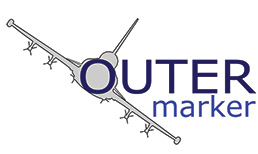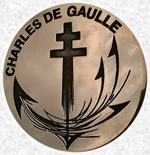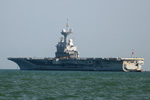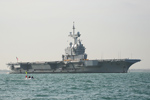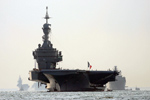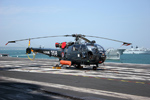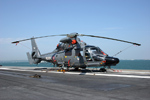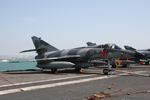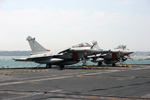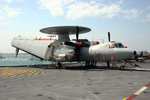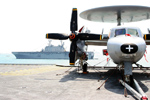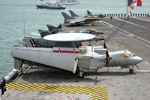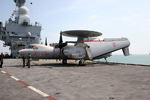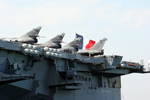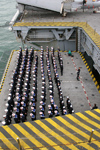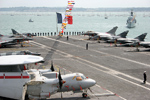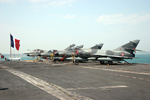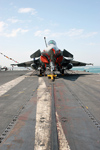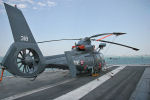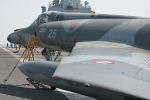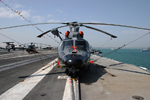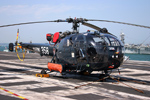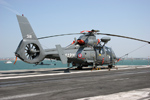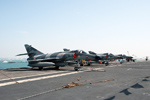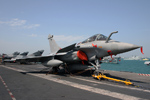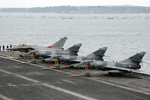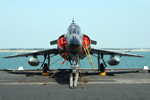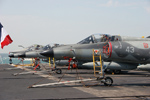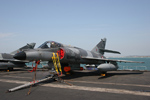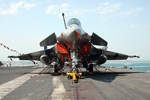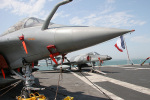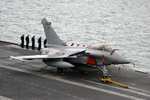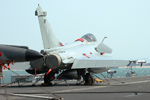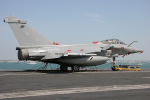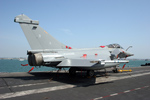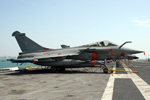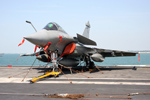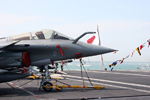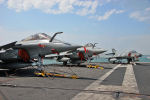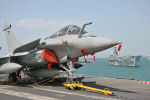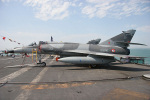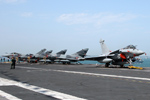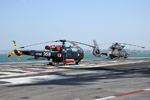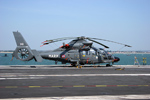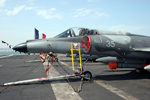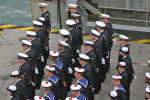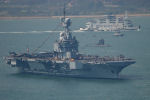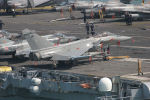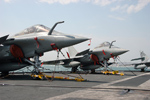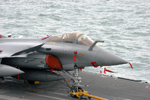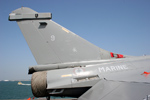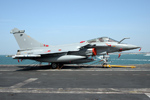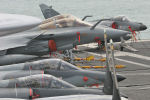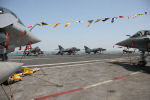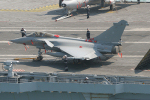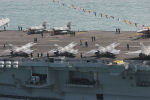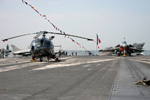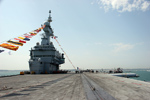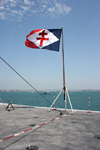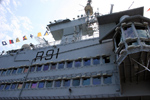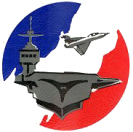
 |
|||||
| Author:
Paul Tiller Photography: Author & Robin Powney |
|||||
In June 2005, Portsmouth Harbour and the waters of the Solent hosted a gathering of vessels from Navies around the world who had been invited to participate in the International Fleet Review (IFR), hosted by the Royal Navy, as part of the 200 years celebrations of Admiral Lord Nelson’s victory at the Battle of Trafalgar. Over 135 vessels, including submarines and Tall Ships, were in attendance and it was a truly international event with participation from Algeria, Australia, Belgium, Brazil, Canada, Denmark, Estonia, France, Germany, Greece, India, Indonesia, Italy, Japan, Morocco, the Netherlands, Pakistan, Russia, South Africa, South Korea, Spain and the United States of America. |
|||||
|
The
de Gaulle was constructed at the DCN Brest naval shipyard and launched
in May 1994. The lead-up to it entering service was not a smooth journey
due to various technical problems and political opposition. In January
1999 the carrier commenced an extensive programme of sea trials during
which it was established that the flight deck was too short to conduct
E-2C Hawkeye operations. To overcome this, the flight deck was lengthened
by a further 4.4 metres and this was sufficient for the E-2C Hawkeye
to land and clear the flight deck. |
The flight deck consists of a main runway which is 195m long and angled at 8.5° to the ship's axis. The whole deck measures 260 x 64m. The aircraft launching areas are each equipped with a USN Type C13F catapult, 75m (246 ft) in length, which have the capability of launching one aircraft per minute. The sea trials also showed that the carrier is capable of conducting flight operations in very heavy sea conditions – Sea State 6 – with wind speeds of up to 33 knots and 20ft waves due to the SATRAP computerised, integrated stabilisation system which is designed to maintain the ships stabilisation to within 0.5° of the horizontal axis. Four pairs of stabilising fins have been fitted and these contribute to improved handling at sea. |
|
|
In
September 2000 the carrier was commissioned with the planned entry to
service to be made in December 2000. But a further setback occurred.
During some long-distance sea trials one of the propeller blades broke
which resulted in them being replaced with the blades from the de Gaulle’s
predecessor, the “Foch”. The manufacturer of the newer blades
had gone out of business so re-designed replacements could not be sourced.
With entry to service being delayed further the de Gaulle was finally
declared operational in April 2001. In June 2001 the de Gaulle conducted
a series of further exercises in the Mediterranean which were without
any major problems. |
The
de Gaulle is designed to go to sea with an embarked airwing of up to
forty aircraft and the hangar deck can accommodate 20-25 aircraft, approximately
half of the air wing. In December 2001, as part of UN Task Force 473
and under “Operation Héraclès”, it was sent
to the Indian Ocean with a reduced airwing comprising two E-2C Hawkeyes,
sixteen Super Etendards, two Dauphin 2’s, one Alouette III and
seven Rafale Ms. This airwing packed a sizeable punch and was to be
put to useful effect. On 19th December Super Etendard aircraft carried
out their first reconnaissance and bombing missions above Afghanistan
covering an area of 3000km2. In total over 770 missions were flown by
the Etendards, averaging twelve per day with five reported instances
where the aircraft had to avoid Stinger missiles being fired at them.
|
|
|
Of
note, at least until early March when AdA Mirage 2000s were forward
deployed to Manas, was that the Super Etendards, together with AdA Mirage
IVPs, were the only non-US aircraft over Afghanistan. Whilst out in
the Indian Ocean, the de Gaulle operated in close proximity with USN
carriers and as such often hosted each others aircraft and ship's personnel
(28 February 2002 saw an E-2C from the USS John C Stennis land aboard
the de Gaulle and on 14 March a French E-2C land on the Stennis). |
This
deployment was the first time Rafale Ms had been at sea and they used
the opportunity afforded to them to continue training and working up
the Rafale M on the de Gaulle - the seven Rafales racked up some 1,600
cat shot cycles and 2,100 flight hours. On two occasions, aircraft flew
direct from Istres to the carrier and in doing so covered 3,300 nautical
miles in roughly seven hours. The Rafales also took part in joint exercises
and mock dogfights with USN F-14 Tomcats and F/A-18 Hornets - the results
are said to have been 'positive' with the slow-speed handling of the
Rafale taking the USN pilots by surprise. In July 2002 the de Gaulle
returned to its home port of Toulon. |
|
|
The
current Rafale Ms are F1 standard and do not have an air-to-ground capability
so cannot yet replace the ageing Super Etendards of 11 Flotille and
17 Flotille, a type that made its first flight in 1974 and will eventually
be replaced by the Rafale M in the 2010 timeframe; they do however have
a vital role to play aboard the Charles de Gaulle in that they provide
the carrier strike group with much needed air cover (although only with
Mica radar guided AAMs), replacing the 1950s vintage F-8E Crusader.
|
F2
standard Rafales began testing at Mont de Marsan in late 2004 and will
eventually be able to deliver the full arsenal of French munitions including
the Mica IR-guided AAM as well as improved air-to-air capability. This
will include the MIDS datalink as well as “Scalp” a jamming
resistant passive optronic surveillance and imaging system with a laser
range finder search and track system mounted forward of the cockpit
– this will supplement the radar for passive multi-target tracking
and identification. Nuclear munitions and Exocet anti-shipping missile
delivery will come with the introduction of the F3s (Rafale N) from
2007 onwards. |
|
|
In
the mean time, the Super Etendards can fulfil almost any strike role
called upon them, from anti-surface warfare to an ASMP-equipped nuclear
strike. Furthermore, Super Etendards are also being continually upgraded
to take advantage of new technologies and will continue to be upgraded
until the Rafale M completely takes over. Providing the important search
and rescue cover during carrier operations (launching and recovery)
as well as logistical support are the Dauphin 2 and Alouette III helicopters
and in the future the ship will also support the AS565 Panther light
multi-role helicopters (this is basically an advanced version of the
Dauphin helicopter) or Eurocopter NH90 NFH maritime combat/transport
helicopters – the NH90 being the first ever medium-size fully
fly-by-wire helicopter with no mechanical backup! |
More
recently in March 2005 the de Gaulle took to the sea again, this time
with a full airwing embarked to participate in the three week exercise
“Trident d’Or 05” near Corsica in the Mediterranean.
This exercise was jointly organised by France and Italy with participation
from Canada, Germany, UK, Spain, Greece, Turkey and the US. The exercise
was a further step in the integration of the French naval components
in the NATO Response Force (NRF) and after four days of evaluation the
de Gaulle returned to port with the airwing disembarking to their respective
land bases of Landivisiau, Lann-Bihoué and Hyères |
|
|
In
May, further exercises took place and whilst taking part in MNME 05-1
off the east coast of the USA alongside USS Dwight D. Eisenhower, USS
Theodore Roosevelt and numerous other Canadian, French, British, Spanish
and US ships and personnel, the de Gaulle and Eisenhower (Ike) occasionally
swapped aircraft to conduct cross-deck tactical training as a step towards
certification of the NRF. The crew of the de Gaulle, together with the
assistance of CVW-7 personnel from the Ike, trapped and launched a VAW-121
E-2C Hawkeye, a C-2A Greyhound and, for the first time ever, an F/A-18C
Hornet of VFA-131 on the de Gaulle. Similarly, Ike trapped and launched
an E-2C from 4 Flotille and witnessed numerous 'bolters' from a 12 Flotille
Rafale M. Following bad weather eight Super Etendards, one Rafale M
and one Hawkeye had to divert to a CONUS (CONtinental US) airbase, yet
they were refused permission at McGuire AFB and ended up at the commercial
airport in Atlantic City. |
In
early June the de Gaulle took part in “Exercise CANFREX”
which was held off the coast of Canada where, for five days, the de
Gaulle participated in exercises with other French naval vessels and
the Canadian Navy. Following the completion of this exercise the de
Gaulle returned to France and briefly visited Cherbourg before sailing
to Portsmouth for the IFR. After the visit to Portsmouth the de Gaulle
sailed to Brest for a two day visit, following which the next stop would
be Toulon in early July where it will be readied for another sailing
later in the year. |
|
|
The
French Navy has plans to build a second carrier which will not be the
same class as the de Gaulle as the requirement is for a conventionally-powered
carrier, not nuclear powered. The design phase of this carrier programme
(PA2) was launched in January 2005 and the production phase is scheduled
to begin in 2006. The design of the new carrier remains to be decided
but it is possible that it will be identical / similar to the BAe/Thales
design proposed for the Royal Navy. In 2014 the de Gaulle is scheduled
for a refit and refueling which also coincides with plans for the second
carrier to enter service in the same year. |
The author would like to thank Lt Claire Zimmerlin, the Royal Navy Trafalgar 200 office, Gemma King RNR and the personnel of R91 P.A Charles de Gaulle. |
